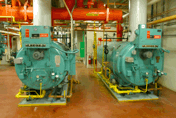|
|
|
Boiler Lay-Ups
|
 Boilers need protection when they are down for inspection or off-line for a period of time. Many boilers are either; 1) left full of water, 2) drained or 3) flushed, drained and left open. During these non-load, non-operational conditions, most of the corrosion and rusting of internal boiler surfaces occurs, which can lead to tube leaks and rust-colored water upon start-up or resumption of a process load. Boilers need protection when they are down for inspection or off-line for a period of time. Many boilers are either; 1) left full of water, 2) drained or 3) flushed, drained and left open. During these non-load, non-operational conditions, most of the corrosion and rusting of internal boiler surfaces occurs, which can lead to tube leaks and rust-colored water upon start-up or resumption of a process load.
Only oxygen and water are required for boiler corrosion to occur. Additional corrosion may occur from acidic carbon dioxide attack. When a boiler is off-line, it cools down, and the water remaining in the boiler is able to absorb oxygen and carbon dioxide gasses. The oxygen depletes the remaining sulfite-chemical protection and the carbon dioxide reduces boiler alkalinity, driving pH down to 6.6 - 6.8, (which is slightly acidic).
Draining a boiler doesn't prevent corrosion as there is always moisture is always in the boiler. Moisture levels can vary while open, dependent upon the; 1) condition of valves, 2) location of the boiler room, and 3) atmospheric humidity levels during periods of downtime. (Small areas of moisture will actually reach oxygen saturation and acidic pH [corrode] much faster than full boiler.)
Preventing Downtime Corrosion: ServeTech recommends one of two different lay-up methods to help prevent downtime corrosion of boilers:
DRY (EMPTY)
- Vapor Phase Corrosion Inhibitors (VCI) have become another method of dry lay up in recent years. This method may be the best dry lay-up alternative, due to the nature of the chemical compound and packaging.
- Desiccant Trays placed inside the boiler, contain chemicals specifically compounded absorb the water from the air in the empty boiler. This method is excellent for long term storage and will also withstand freezing temperatures in unheated buildings. There are two disadvantages with this method; 1) the desiccant needs periodic inspection to insure that it is still good, requiring the opening of the boiler, which lets in more moisture, and 2) the desiccant needs to be removed and the boiler internals cleaned of any remaining desiccant prior to returning the boiler to service.
WET (WATER)
- Custom-compounded lay-up chemical is added to the water to prevent oxygen corrosion and low pH attack of boiler surfaces. Your ServeTech technician will calculate the correct chemical level, water level/volume in the boiler and prescribe sampling/testing procedures to ensure continuous protection during the lay-up period. (After the addition of the lay-up chemical, the boiler needs to be overfilled up to the steam header shut off valve, which must be closed to prevent contact with any air in the steam line). Restoring the boiler to normal operation requires that the boiler water be dropped to the normal operating level, and that the normal treatment program be resumed, (no washing, draining, or flushing is required). Wet lay-up should not be prescribed in an unheated building where freezing can occur.
Lay-Up Treatment Products: ServeTech can provide either a liquid product or a solid-concentrated product to lay-up and protect your boiler. ServeTech technicians will calculate the correct dosage to ensure maximized system protection to match the lay-up state, (wet or dry).
|
|
The material provided in this bulletin is informational in nature and is not intended to be instructions for a particular location or installation. There is no guarantee, warranty or other assurance of fitness of purpose or operational performance or results either express or implied. The user assumes all risk in following the information provided. Always read and follow product safety and performance instructions on product labels, Material Data Safety Sheets and those provided specifically for your requirements by your ServeTech representative.
|
|
ServeTech Water Solutions, Inc. - Wheaton, IL - www.servetechwater.com - info@servetechwater.com - 630-784-9050
|
|
|